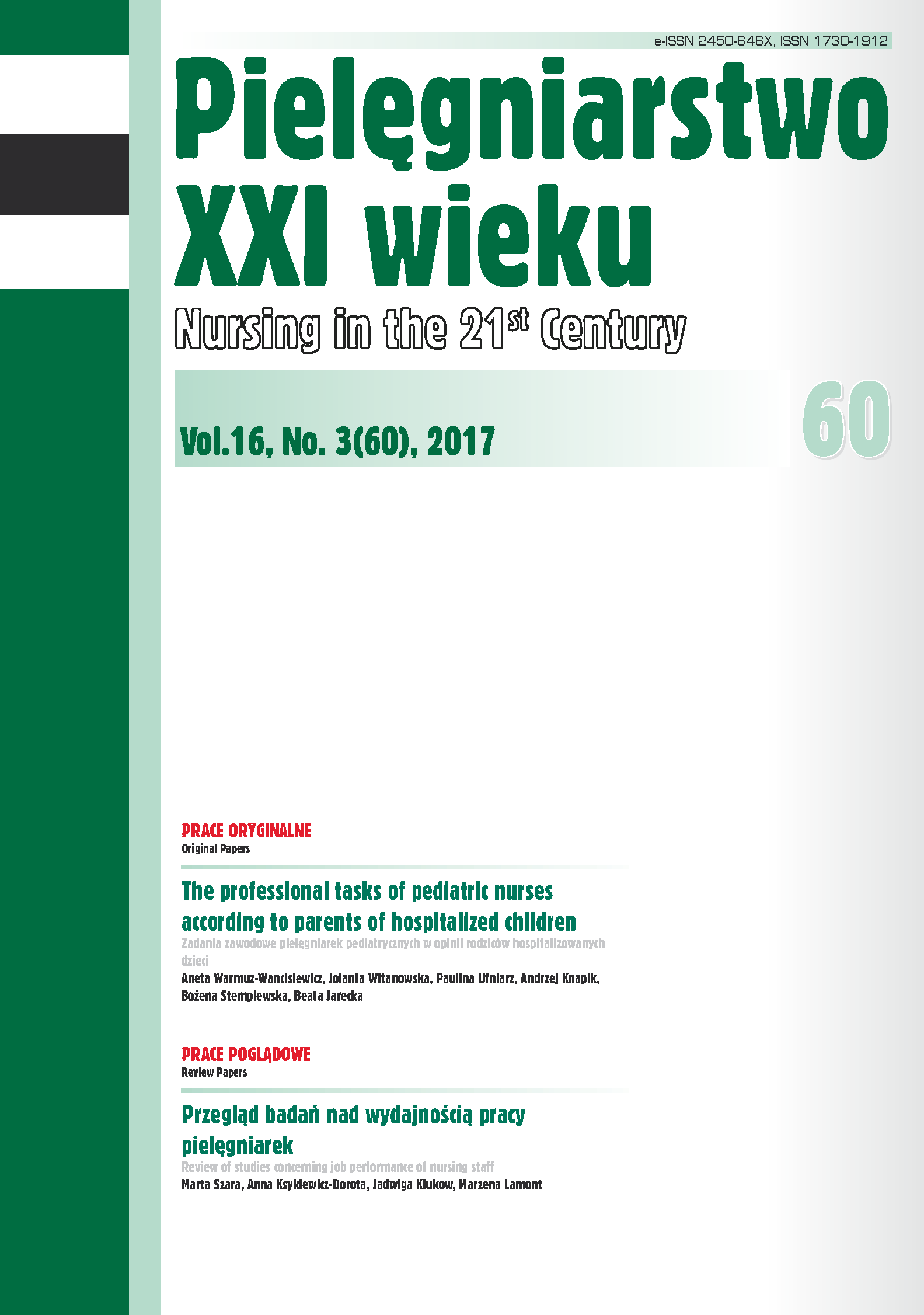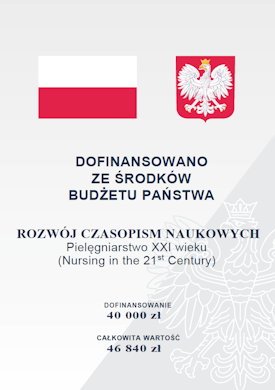Przegląd badań nad wydajnością pracy pielęgniarek
DOI:
https://doi.org/10.1515/pielxxiw-2017-0023Słowa kluczowe:
wydajność pracy, pielęgniarstwo, zarządzanie w pielęgniarstwieAbstrakt
PRZEGLĄD BADAŃ NAD WYDAJNOŚCIĄ PRACY PIELĘGNIAREK
Wprowadzenie. Wydajność pracy, czyli całkowita wartość zachowań oczekiwanych od pracowników w czasie oceny przeprowadzonej w ustalonym czasie. W podstawowym i dychotomicznym podziale odnosi się wydajność do płaszczyzny zachowań pracowniczych (behawioralny) oraz wyników ich pracy. Dodatkowo badacze wyróżniają: wydajność zadaniową, wydajność kontekstową oraz wydajność adaptacyjną.
Wnioski. Tematyką wydajności pracy pielęgniarek zajmowano się w badaniach autorów obcych od lat 60-tych XX wieku. Do chwili obecnej jest ona aktualna, ale mało rozpoznana w krajowym piśmiennictwie [1,2,3]. W publikacjach zagranicznych autorzy donoszą, że wieloaspektowe zjawisko wydajności pracy uzależnione jest od wielu zmiennych. Udowodniono w licznych badaniach związek wydajności pracy z cechami osobowymi pracownika, pracą zmianową, poziomem stresu, wsparciem społecznym, relacjami interpersonalnymi, przywództwem, a także kulturą organizacyjną.
Bibliografia
1. Łyś D. Analiza wydajności pracy personelu medycznego. OPM. 2011; 7: 60-62.
2. Sierpińska L, Ksykiewicz-Dorota A. Klimat organizacyjny jako warunek wstępny efektywnej pracy zespołu terapeutycznego. Ann. UMCS, Sect. D 2003; 58(2): 136-141.
3. Smoleń E, Ksykiewicz-Dorota A. Struktura czasu pracy pielęgniarek pediatrycznych na oddziałach szpitalnych o różnym poziomie referencyjnym. Med. Pr. 2017; 68(1): 95-103.
4. Dilworth AS. Measure of nursing performance. Nurs Res. 1960; 9(4): 217.
5. Tate BL. Evaluation of clinical performance of the staff nurse. Nurs Res. 1962; 7(1): 7-9.
6. Jahromi Z, Kargar M, Ramezanli S. Study of the Relationship Between Nurse Self-Concept and Clinical Performance Among Nursing Students. Jentashapir J Health Res. 2015; 6(5): 54-58.
7. Baethge A, Müller A, Rigotti T. Nursing performance under high workload: A diary study on the moderating role of selection, optimization and compensation strategies. J AdvNurs. 2016; 76 (3): 545-557.
8. Campbell JP. Modeling the Performance Prediction Problem in Industrial and Organizational Psychology’, in M. D. Dunnette and L. M. Hough (eds), Handbook of Industrial and Organizational Psychology. Vol. 1, Wydawnictwo PaloAlto: Consulting Psychologists Press; 1990, s. 687-732.
9. Motowidlo S, Borman W, Schmidt N. A theory of individual differences in task and contextual performance. Human Performance. 1997; 10: 71-83.
10. Sonnetag S, Volmer J, Spychala A. Job performance. w: Barling J, Cooper CL. (red). The SAGE Handbook of Organizational Behavior, Volume One: Micro Approaches, Los Angeles. California: Wydawnictwo SAGE Publications Ltd.; 2008, s.427-447.
11. Hesketh B, Neal A. Technology and Performance. w: Ligen DR., Pulakos ED. (red).The Changing Nature of Performance: Implications for Staffing, Motivation, and Development, San Francisco: Wydawnictwo Jossey-Bass; 2000, s.21-55.
12. Sotter J, Motowidlo S. Interpersonal Facination and job dedication asseparate facets of contextual performance. J Appl Psychol. 1996; 181(5): 525-531.
13. Murphy PR, Jackson SE. Managing Work Role Performance. Challenging the Twenty First Century Organizations and Their Employees, w: Ligen DR., Pulakos ED. (red). The Changing Nature of Performance: Implications for Staffing, Motivations, and Development. San Francisco: Wydawnictwo Jossey-Bass: 1999, s.325-365.
14. London M, Mone EM. Continuous Learning, w: Ligen DR., Pulakos ED. (red). The Changing Nature of Performance: Implications for Staffing, Motivation, and Development. San Francisco: Wydawnictwo Jossey-Bass; 1999, s.119-153.
15. Pulakos ED, Arad S, Donovan M A, et al. Adaptability in the workplace: Development of a taxonomy of adaptive performance. J Appl Psychol. 2000; 85: 612-624.
16. While AE. Competence versus performance: which is the most important? J AdvNurs. 1994; 20: 525-531.
17. Robb Y, Fleming V, Dietert Ch. Measurement of clinical performance of nurses: a literature review. Nurs Educ Today. 2002; 22: 293-300.
18. Al-Makhaita HM, Sabra AA, Hafez AS. Job performance among nurses working in two different health care levels, Eastern Saudi Arabia: A comparative study. Int J Med Sci Public Health. 2014; 7(3): 832-837.
19. Dahiru T, Aliyu A, Acne TS. Statistics in medical research misuse of sampling and sample size determination. Ann Afr Med. 2006; 5(3): 158-161.
20. Fitzpatrick J, While A, Roberts J. Shift work and its impact upon nurse performance: current knowledge and research issues. J Adv Nurs. 1999; 29(3): 18-27.
21. Buljac-Samardzic M, Dekker-van Doorn C, van Wijngaarden JDH, et al. Interventions to improve team effectiveness: A systematic review. Health Policy. 2010; 94: 183-195.
22. AbuAlRub RF. Job Stress, Job Performance and Social Support Among Hospital Nurses. J Nurs Scholarship. 2004; 36 (1): 73-78.
23. Bartlett H, Simonite V, Westcott E, et al. A comparison of the nursing competence of graduates and diplomats from UK nursing programmes. Clin Nurs. 2000; 9: 369-381.
24. Roud D, Giddings L, Koziol-McLain J. A longitudinal survey of nurses’ self-reported performance during an entry to practice programme. Nurs Prax New Zeal. 2005; 21(4): 37-46.
25. Swanson M. Baccalaureate Nursing Education: Students’ Perceptions of Roles, Effort, and Performance. J Nurs Educ. 1987; 26 (9): 380-383.
26. Takase M, Kershaw E, Burt L. Nurse-enviroment misfit and nursing practice. J Adv Nurs. 2001; 35(6): 819-826.
27. Roche M, Duffield Ch, Friedman S, et al. Regulated and unregulated nurses in the acute hospital settings: Task performed, delayed or not completed. J Clin Nurs. 2015; 25: 153-162.
28. Vaughan F. What is Spiritual Intelligence? J Humanist Psychol. 2002; 42 (2): 16-33.
29. Rani AA, Abidin I, Hamid MR. The Impact of Spiritual Intelligence on Work Performance: Case studies in Government Hospitals of East Cost Malaysia. The Macrotheme Review. 2013; 2(3): 46-59.
30. Beauvais AM, Brady N, O’sha ER, et al. Emotional intelligence and nursing performance among nursing students. Nurs Educ Today. 2011; 31: 396-401.
31. Fujino Y, Tanaka M, Yonemitsu Y, et al. The relationship between characteristic of nursing performance and years experience on nurses with high emotional intelligence. Int J Nurs Pract. 2014; 21: 876-881.
32. Top M. Organizational Variables on Nurses’ Job Performance in Turkey: Nursing Assessments. Iranian J Publ Healh. 2013; 42(3): 267-271.
33. Amarneh BH, Al-Rub RF, Al-Rub NF. Co-workers’ support and job performance among nurses in Jordanian Hospitals. J Res Nurs. 2010; 15(5): 391-401.
34. Fujino Y, Kawamoto R. Effect of Infomation and Communication Technology on Nursing Performance. CIN-Comput Inform Nu. 2013; 32(5): 244-250.
Opublikowane
Numer
Dział
Licencja
Prawa autorskie (c) 2017 Autorzy

Praca jest udostępniana na licencji Creative Commons Attribution-NonCommercial-NoDerivatives 3.0 Unported License.




